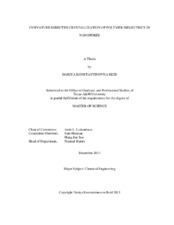| dc.contributor.advisor | Lutkenhaus, Jodie | |
| dc.creator | Reid, Dariya | |
| dc.date.accessioned | 2014-05-13T17:25:54Z | |
| dc.date.available | 2015-12-01T06:31:16Z | |
| dc.date.created | 2013-12 | |
| dc.date.issued | 2013-11-26 | |
| dc.date.submitted | December 2013 | |
| dc.identifier.uri | https://hdl.handle.net/1969.1/151830 | |
| dc.description.abstract | The formation of isotactic poly(propylene) (iPP) and polycarbonate (PC) nanowires of tunable diameter was demonstrated by melt-wetting the polymer into nanoporous anodic alumina. The crystallization process was analyzed using differential scanning calorimetry. A transition from hetero- to homogeneous crystallization was observed for iPP as the pore diameter decreased. Also, the Avrami exponent decreased as the pore diameter decreased, indicating preferential 1-D crystallization for diameters of 40 nm or less. X-ray diffraction studies showed that the polymer chains crystallize into the α-phase and that they preferentially orient along the a- and b-axis, perpendicular to the pore wall. Directed crystallization of iPP may enhance the materials electrical and mechanical properties. | en |
| dc.format.mimetype | application/pdf | |
| dc.language.iso | en | |
| dc.subject | isotactic poly(propylene) | en |
| dc.subject | confinement effects | en |
| dc.subject | Avrami kinetics | en |
| dc.subject | directed crystallization | en |
| dc.subject | anodic aluminum oxide | en |
| dc.subject | nanowires | en |
| dc.title | Curvature-directed Crystallization of Polymer Dielectrics in Nanopores | en |
| dc.type | Thesis | en |
| thesis.degree.department | Chemical Engineering | en |
| thesis.degree.discipline | Chemical Engineering | en |
| thesis.degree.grantor | Texas A & M University | en |
| thesis.degree.name | Master of Science | en |
| thesis.degree.level | Masters | en |
| dc.contributor.committeeMember | Mannan, Sam | |
| dc.contributor.committeeMember | Sue, Hung-Jue | |
| dc.type.material | text | en |
| dc.date.updated | 2014-05-13T17:25:54Z | |
| local.embargo.terms | 2015-12-01 | |


